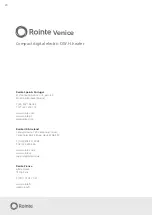
8
4.5. Expansion relief valve
This must be installed between the pressure reducing valve and the water heating . No other valve
should be fitted between this valve and the cylinder. The expansion relief valve contains a non
return valve.
4.6. Expansion vessel
The expansion vessel MUST be fitted to the safety group. The expansion vessel MUST be positioned
with the entry point at the bottom
IMPORTANT:
Regular checks must be carried out to ensure that the expansion vessel is correctly
pressurised to 0.15 or 0.3 MPa at all times.
4.7. Tundish
The tundish must not be positioned above or in close proximity to any electrical current carrying
devices or wiring.
4.8. Discharge arrangement
The tundish must be installed in a position so that it is clearly visible by the user. In addition, the discharge
pipe from the tundish should terminate in a safe place where there is no risk to persons in the vicinity of the
discharge, be of metal and:
4.8.1.
Be at least one pipe size larger than the normal outlet size of the safety device unless its total equipment
hydraulic resistance exceeds that of a straight pipe 9m long, i.e. discharge pipes between 9m and
18m equivalent resistance length should be at least two sizes larger then the normal outlet size of the
safety device, between 18m and 27m at least three sizes larger and so on. Bends must be taken into
account in calculating the flow resistance. Refer to Figure 3, Table 1 and Calculated Example 1.
4.8.2.
Have a vertical section of pipe at least 300 mm long below the tundish before any elbows or bends
in the pipework.
4.8.3.
Be installed with a continuous fall.
4.8.4.
Have discharges visible at both tundish and the final point of discharge, but where this is not
possible or practically difficult, examples of acceptable discharge arrangements are:
– Ideally below a fixed grating and above the water seal in a trapped gully.
– External surfaces such as car parks, hard standings, grassed areas, etc.) are acceptable providing
that where children play or otherwise come into contact with discharges, a wire cage or similar
guard is positioned to prevent contact whilst maintaining visibility.
– Discharge at high level, e.g. into a metal hopper and metal down pipe with the end of the
discharge pipe clearly visible (tundish visible or not) or onto a roof capable of withstanding high
temperature discharges of water and 3 m from any plastic guttering system that would collect
such discharges (tundish visible).
Summary of Contents for 8436045913159
Page 1: ...Compact digital electric D W H heater INSTRUCTION INSTALLATION GUIDE Venice ...
Page 2: ...2 ...
Page 16: ...16 ...
Page 17: ...17 NOTES ...
Page 18: ...18 NOTES ...
Page 19: ...19 ...




















